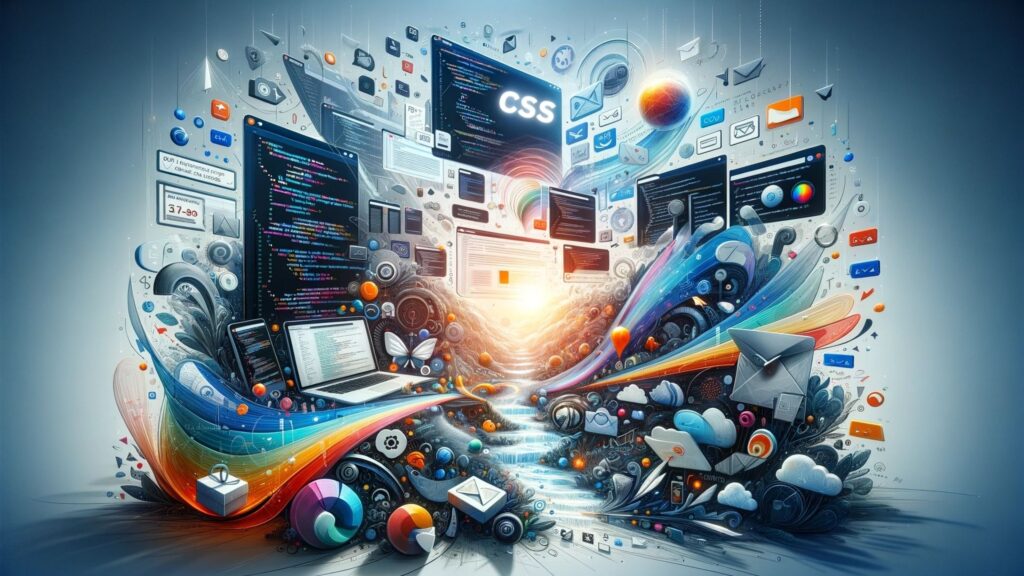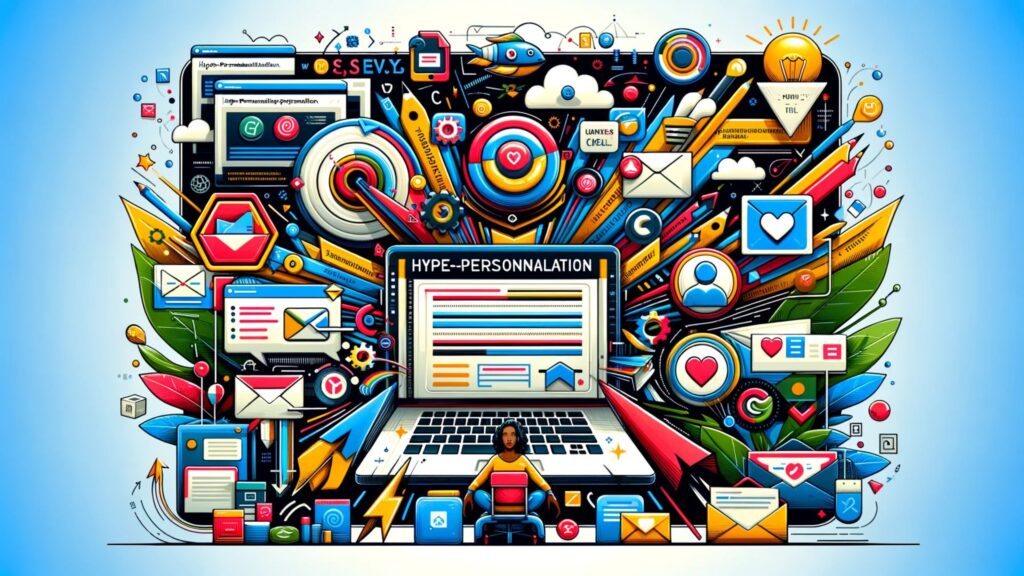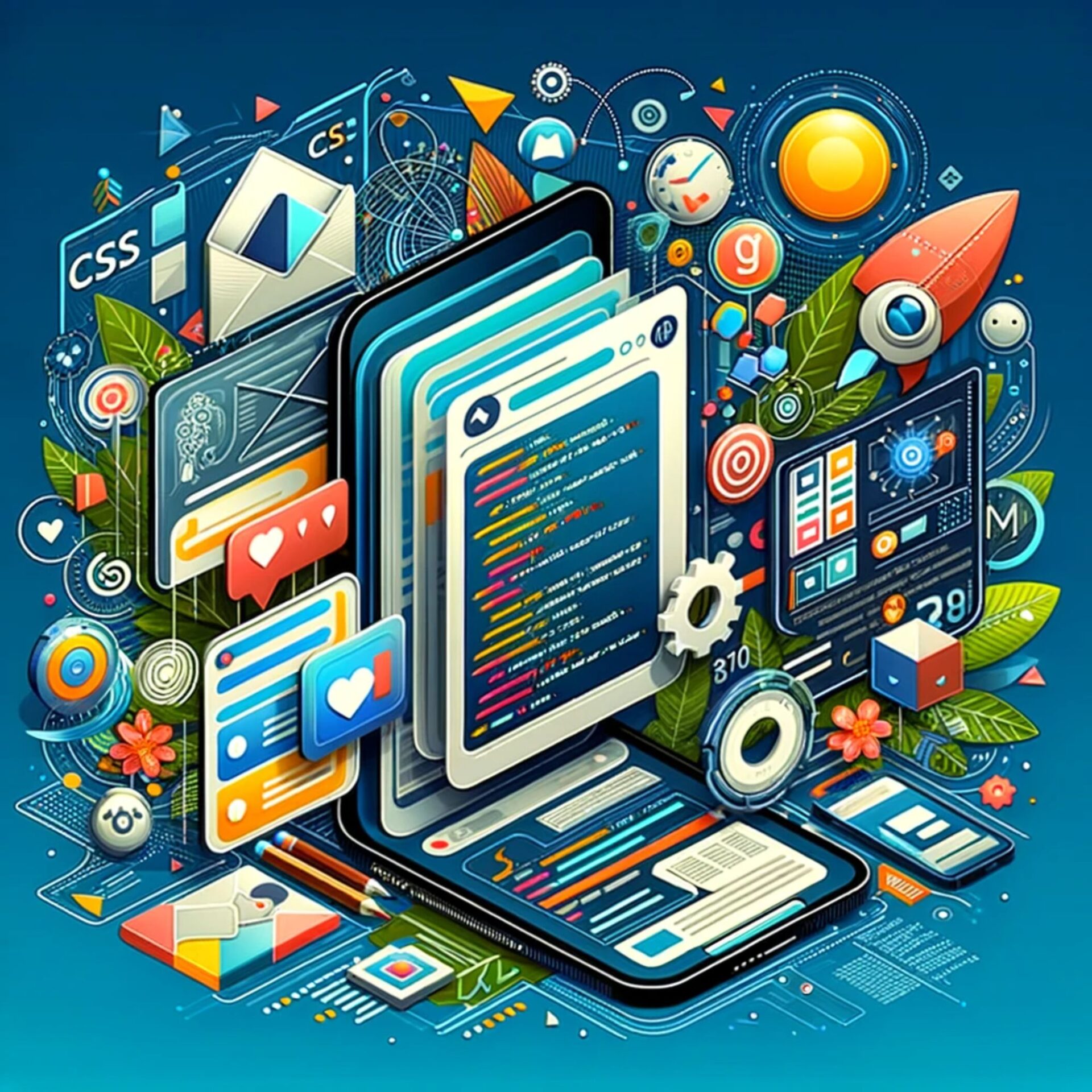Email marketing continues to be a vital tool for businesses, offering a direct line of communication with customers. At the heart of effective email design is Cascading Style Sheets (CSS), a technology that shapes the visual presentation of emails. In this section, we’ll explore the significance of CSS in email templates, offering insights into how it transforms simple messages into engaging and professional-looking communications.
CSS plays a pivotal role in email design. It’s the magic behind the visual appeal of your email campaigns, determining everything from the layout, colors, to the font styles of your emails. Unlike web design, where CSS has vast possibilities, email templates demand a more nuanced approach. This is because various email clients like Outlook, Gmail, and Yahoo Mail interpret CSS differently. Therefore, understanding the basics and best practices of CSS in email contexts becomes crucial for creating visually appealing and universally compatible email templates.
The evolution of CSS in email marketing has been fascinating. Initially, email designs were predominantly table-based, limiting creativity and flexibility. However, as CSS support across email clients improved, it opened the door to more sophisticated, responsive, and personalized designs. Today, CSS is not just about making emails look good; it’s about creating an experience that resonates with the audience, enhancing engagement, and ultimately driving action.
As we explore CSS for email templates, we focus on practical tips and tricks, compatibility considerations, and the latest trends to help you create stunning emails that look great in every inbox. Whether you’re a seasoned designer or just starting out, understanding the role of CSS in email design is key to crafting compelling email campaigns that captivate and convert.
Understanding the Basics of CSS for Emails
CSS (Cascading Style Sheets) is the backbone of email template design, responsible for the aesthetic appeal and readability of your emails. Mastering CSS for emails is a blend of art and science. Let’s break down the key CSS properties used in email templates and examine the compatibility challenges posed by different email clients.

Key CSS Properties in Email Templates
1. Layout Properties:
- Width and Height: These properties define the size of elements like images and tables.
- Padding and Margin: Essential for controlling the space around and inside elements. Padding adds space inside an element, while margin adds space outside.
- Border: Defines the border around elements, useful for creating visually distinct sections in your email.
2. Font and Text Properties:
- Font-family, Font-size, and Color: These properties are crucial for readability. It’s important to use web-safe fonts to ensure consistency across different email clients.
- Text-align and Line-height: These properties help in aligning your text and adjusting the space between lines for better readability.
3. Background Properties:
- Background-color and Background-image: They add visual interest to your emails. However, not all email clients support background images, so fallback colors are important.
4. Table Properties:
- Border-collapse and Table-layout: Since many email designs still rely on tables, these properties help in controlling the table layout and border styles.
Compatibility Challenges with Different Email Clients
One of the biggest challenges in email design is ensuring your emails look consistent across various email clients. Here’s why:
- Varying CSS Support: Email clients like Outlook, Apple Mail, and Gmail support different subsets of CSS. For instance, Outlook uses Microsoft Word for rendering, which can be limited in CSS support.
- Media Query Limitations: Responsive design relies on media queries. However, some email clients do not support them, which can affect the mobile responsiveness of your emails.
- Rendering Differences: Even common properties like padding and margin can render differently in various clients, impacting the layout and spacing.
- Fallbacks and Inline Styling: To navigate these challenges, it’s essential to use CSS inline styles and provide fallbacks. Inline styles are more universally accepted by email clients. Fallbacks ensure that even if a certain property is not supported, the email still retains a presentable format.
A strong grasp of CSS properties and an understanding of the unique rendering behaviors of different email clients are key to creating effective and visually appealing email templates. The goal is to ensure a consistent and engaging experience for every recipient, regardless of how they access their emails.
By considering these aspects, you can create email templates that not only capture attention but also deliver your message effectively across various platforms.
Responsive Design and Mobile Optimization
With the majority of emails now being opened on mobile devices, it’s crucial for email designers to prioritize responsive design and mobile optimization. This section covers techniques for making CSS grids responsive and underscores the importance of a mobile-first approach in email templates.
Making CSS Grids Responsive
1. Flexible Layouts:
- Use percentage-based widths instead of fixed pixel widths to allow elements to adjust fluidly across different screen sizes.
- Employ a fluid grid system that adapts to the screen size, ensuring content looks good on any device.
2. Media Queries:
- Media queries are pivotal in responsive design. They enable CSS to apply different styles based on the device’s characteristics, like its width.
- For emails, use simple media queries to adjust layouts for smaller screens, such as changing column structures or resizing fonts.
3. Stacking Columns on Mobile:
- Convert multi-column layouts into single columns for smaller screens. This stacking ensures content is easily readable on mobile devices.
- Use CSS to change the display properties or reorder elements when viewed on a mobile device.
4. Scalable Images:
- Make images responsive so they scale with the layout. Set the max-width of images to 100% and ensure their width adjusts automatically to the container size.
5. Touchable Elements:
- Increase the size of clickable elements like buttons for touch-friendly navigation. A larger, easy-to-tap button greatly enhances the user experience on mobile devices.
Importance of Mobile-First Design
- Prioritize the Mobile Experience:
A mobile-first approach means designing the email template for mobile devices first and then scaling up for larger screens. This ensures the primary focus is on the most common viewing environment.
- Enhanced Readability and Engagement:
Mobile-first designs are optimized for smaller screens, which means better readability and engagement. Content is concise, and navigation is simplified, leading to a more effective email campaign.
- Better Performance:
Mobile-optimized emails load faster and perform better. This is crucial since mobile users often have less patience for slow-loading content.
- Higher Conversion Rates:
With a design that’s easy to interact with on mobile, you’re more likely to see higher engagement and conversion rates. Mobile users appreciate and respond better to emails that are tailored to their device.
Responsive design is not just a trend; it’s a necessity in today’s mobile-centric world. By employing these techniques, your emails will not only look great on all devices but also provide a seamless user experience that can lead to increased engagement and conversions.
Innovative Uses of CSS in Email Design
The landscape of email design is continually evolving, introducing innovative ways to enhance aesthetics and functionality. In this part of the article, we explore the concept of modular email design for greater flexibility and consistency, and examine the emerging role of Generative AI (GenAI) in augmenting imagery and copy in email templates.

Modular Email Design: Flexibility and Consistency
Modular email design refers to the use of reusable components or ‘modules’ to build email templates. This approach streamlines the email creation process and offers several benefits:
1. Efficiency and Speed: With pre-designed modules, you can quickly assemble emails without starting from scratch each time. This significantly speeds up the design process, especially for businesses that need to send out emails regularly.
2. Brand Consistency: Modular design ensures that all your emails maintain a consistent look and feel, reinforcing your brand identity. By using the same set of modules across different emails, you create a uniform visual language that your audience will recognize.
3. Customization and Flexibility: Despite the use of standard modules, there’s ample room for customization. You can mix and match different modules to suit the specific needs of each email campaign, giving you flexibility while maintaining consistency.
4. Scalability: As your email marketing strategy evolves, modular design makes it easy to update and scale your templates. You can add new modules or modify existing ones to keep up with changing trends and requirements.
GenAI in Email Template Design
Generative AI, a breakthrough in artificial intelligence, is beginning to play a significant role in email template design:
1. Enhanced Imagery and Copy: GenAI can significantly improve the quality of images and text used in email templates. It can create high-resolution images from simple prompts and refine copy to match a specific tone or style, making your emails more appealing and effective.
2. Content Personalization: AI algorithms can analyze customer data to generate personalized content. This means your emails can feature products, images, or text that resonate with the individual preferences of each recipient, making them more relevant and engaging.
3. Automation and Efficiency: GenAI can automate various aspects of email design, from generating ideas to crafting entire emails based on predefined outlines. This saves time and resources, allowing marketers to focus on strategy and analysis.
4. Dynamic Content Creation: The ability of GenAI to generate dynamic content ensures that your emails are not just visually appealing but also packed with up-to-date and relevant information, tailored to each recipient.
The integration of modular design and GenAI technologies in email templates represents a significant leap forward in email marketing. These innovations allow for greater efficiency, consistency, and personalization, making email campaigns more effective and engaging.
Advanced CSS Techniques for Email Templates
Elevating email design goes beyond basic aesthetics; it involves integrating advanced CSS techniques to enhance interactivity and visual storytelling. Let’s explore how CSS can be used to implement interactive elements and leverage visual storytelling in emails.
Implementing Interactive Elements Using CSS
1. Hover Effects:
- CSS hover effects can be used to change the color, background, or visibility of elements like buttons and links when a user hovers over them. This enhances user engagement and provides visual feedback.
- Example: a:hover { color: #ff0000; } changes the link color to red when hovered over.
2. CSS Animations:
- Simple CSS animations can add dynamic elements to your emails, capturing the reader’s attention. This could be a subtle fade-in effect for images or text.
- Example: Using @keyframes to create an animation that gradually changes the opacity of an element.
3. Transition Effects:
- CSS transitions are useful for creating smooth, gradual changes in the properties of an element, such as color, size, or position.
- Example: transition: background-color 0.3s ease-in-out; ensures a smooth color change over 0.3 seconds when the element’s background color changes.
4. Interactive Menus and Accordions:
- While limited by email client capabilities, some interactive elements like menus and accordions can be created using CSS, enhancing the email’s functionality.
- Note: Always test these elements across different email clients for compatibility.
Leveraging CSS for Visual Storytelling in Emails
1. Thematic Typography:
- CSS allows for creative typography which can be used to tell a story or highlight key messages in your email.
- Example: Varying font sizes and styles to draw attention to specific parts of the email content.
2. Layering with Z-Index:
- The z-index property in CSS can create depth by layering different elements. This technique can be used to overlay text on images or create a sense of hierarchy in the email layout.
- Example: Setting a higher z-index for important call-to-action buttons to make them stand out.
3. Grid Layouts for Storyboarding:
- CSS Grids can be used to create complex layouts that resemble a storyboard, guiding the reader through the content in a visually coherent manner.
- Example: Arranging images and text in a grid pattern to create a narrative flow.
4. Backgrounds and Gradients:
- Using CSS for gradient backgrounds or full-width images can set the tone and mood of the email, enhancing the storytelling aspect.
- Example: Linear-gradient backgrounds to add visual interest without overwhelming the content.
By implementing these advanced CSS techniques, your email templates can transform from simple messages to engaging, interactive experiences that captivate the reader. Remember, the key is subtlety and ensuring compatibility across various email clients to maintain a consistent user experience.
Hyper-Personalization with CSS
Hyper-personalization in email marketing takes customization to the next level. It’s about crafting emails that resonate personally with each recipient, using CSS to tailor both content and design to individual user experiences. This section highlights how to achieve this with behavior-based product recommendations and dynamic content.

Tailoring Content and Design
1. CSS for Personalized Styling: CSS can be used to change styles based on user data. For example, displaying a different background color or font style based on the recipient’s previous interactions with the brand.
Techniques like class swapping based on user data can personalize the email’s appearance. For instance, a vip-customer class could apply a unique style for high-value customers.
2. Responsive Design for Personalization: Responsive design isn’t just about device compatibility; it also allows for content adaptation. Depending on the user’s device, preferences, or behavior, the email layout can change to suit their specific needs.
Behavior-Based Product Recommendations
1. Dynamic Product Displays: Using CSS and backend data integration, emails can dynamically showcase products or services that align with the recipient’s browsing history or purchase behavior.
For example, if a customer frequently views sports gear on your website, the email can display related products using CSS-styled modules.
2. Personalized Calls-to-Action: Tailoring calls-to-action (CTAs) based on user behavior can significantly increase engagement. CSS can style these CTAs to be more prominent and aligned with the user’s interests.
Dynamic Content
1. Real-Time Content Updates: Incorporate real-time content in emails, such as live weather updates or stock levels, using CSS for styling. This keeps the email relevant and engaging at the moment it’s opened.
2. Personalized Content Blocks: Create different content blocks in the email template, showing or hiding them based on the recipient’s profile. CSS helps in styling these blocks to fit seamlessly into the overall design.
3. User-Specific Information: Display user-specific information like loyalty points or personalized greetings. CSS enhances the presentation of this data, making it more noticeable and integrated into the email’s design.
Hyper-personalization through CSS in email templates offers a unique opportunity to connect with your audience on a personal level. By blending user data with creative CSS techniques, emails can become more than just a message; they become a tailored experience that resonates with each individual, driving higher engagement and loyalty.
Conclusion
The role of CSS in email templates is increasingly pivotal. It underpins the creation of visually appealing, functional, and responsive email designs. Advanced CSS techniques are enhancing interactivity and personalization, making emails more engaging. The integration of CSS with AI is set to revolutionize content dynamism and personalization. Moreover, the trend towards eco-friendly and minimalistic designs reflects a growing environmental consciousness. Future developments in CSS will likely focus on heightened interactivity, accessibility improvements, and adapting to evolving email standards. Staying abreast of these changes is crucial for effective and impactful email marketing in an ever-evolving digital landscape.




